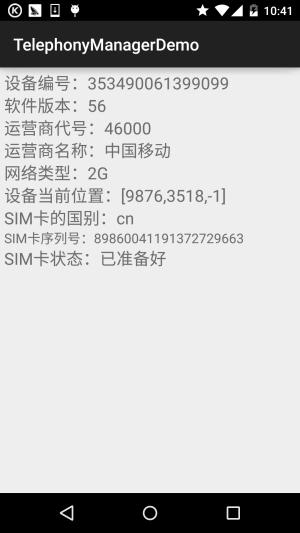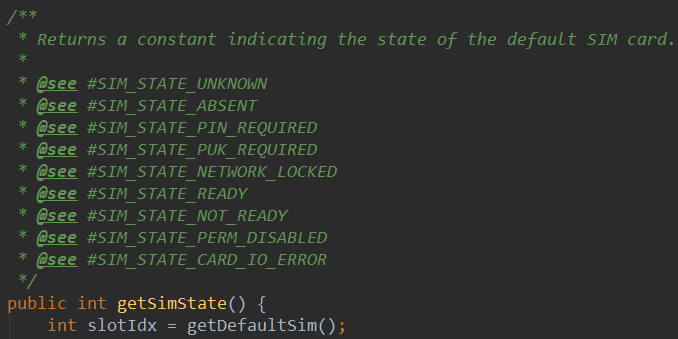本节引言:
1.获得TelephonyManager的服务对象
TelephonyManager tManager = (TelephonyManager)getSystemService(Context.TELEPHONY_SERVICE);
2.用法示例
1)调用拨号器拨打电话号码
Uri uri=Uri.parse("tel:"+电话号码);
Intent intent=new Intent(Intent.ACTION_DIAL,uri);
startActivity(intent);
2)获取Sim卡信息与网络信息
运行效果图:

实现代码:
布局文件:activity_main.xml:
<LinearLayout xmlns:android="http://schemas.android.com/apk/res/android"
xmlns:tools="http://schemas.android.com/tools"
android:layout_width="match_parent"
android:layout_height="match_parent"
android:orientation="vertical"
android:padding="5dp"
tools:context=".MainActivity">
<TextView
android:id="@+id/tv_phone1"
android:layout_width="match_parent"
android:layout_height="wrap_content"
android:textSize="20sp" />
<TextView
android:id="@+id/tv_phone2"
android:layout_width="match_parent"
android:layout_height="wrap_content"
android:textSize="20sp" />
<TextView
android:id="@+id/tv_phone3"
android:layout_width="match_parent"
android:layout_height="wrap_content"
android:textSize="20sp" />
<TextView
android:id="@+id/tv_phone4"
android:layout_width="match_parent"
android:layout_height="wrap_content"
android:textSize="20sp" />
<TextView
android:id="@+id/tv_phone5"
android:layout_width="match_parent"
android:layout_height="wrap_content"
android:textSize="20sp" />
<TextView
android:id="@+id/tv_phone6"
android:layout_width="match_parent"
android:layout_height="wrap_content"
android:textSize="20sp" />
<TextView
android:id="@+id/tv_phone7"
android:layout_width="match_parent"
android:layout_height="wrap_content"
android:textSize="20sp" />
<TextView
android:id="@+id/tv_phone8"
android:layout_width="match_parent"
android:layout_height="wrap_content"
android:textSize="16sp" />
<TextView
android:id="@+id/tv_phone9"
android:layout_width="match_parent"
android:layout_height="wrap_content"
android:textSize="20sp" />
</LinearLayout>
MainActivity.java:
public class MainActivity extends AppCompatActivity {
private TextView tv_phone1;
private TextView tv_phone2;
private TextView tv_phone3;
private TextView tv_phone4;
private TextView tv_phone5;
private TextView tv_phone6;
private TextView tv_phone7;
private TextView tv_phone8;
private TextView tv_phone9;
private TelephonyManager tManager;
private String[] phoneType = {"未知","2G","3G","4G"};
private String[] simState = {"状态未知","无SIM卡","被PIN加锁","被PUK加锁",
"被NetWork PIN加锁","已准备好"};
@Override
protected void onCreate(Bundle savedInstanceState) {
super.onCreate(savedInstanceState);
setContentView(R.layout.activity_main);
//①获得系统提供的TelphonyManager对象的实例
tManager = (TelephonyManager) getSystemService(Context.TELEPHONY_SERVICE);
bindViews();
}
private void bindViews() {
tv_phone1 = (TextView) findViewById(R.id.tv_phone1);
tv_phone2 = (TextView) findViewById(R.id.tv_phone2);
tv_phone3 = (TextView) findViewById(R.id.tv_phone3);
tv_phone4 = (TextView) findViewById(R.id.tv_phone4);
tv_phone5 = (TextView) findViewById(R.id.tv_phone5);
tv_phone6 = (TextView) findViewById(R.id.tv_phone6);
tv_phone7 = (TextView) findViewById(R.id.tv_phone7);
tv_phone8 = (TextView) findViewById(R.id.tv_phone8);
tv_phone9 = (TextView) findViewById(R.id.tv_phone9);
tv_phone1.setText("设备编号:" + tManager.getDeviceId());
tv_phone2.setText("软件版本:" + (tManager.getDeviceSoftwareVersion()!= null?
tManager.getDeviceSoftwareVersion():"未知"));
tv_phone3.setText("运营商代号:" + tManager.getNetworkOperator());
tv_phone4.setText("运营商名称:" + tManager.getNetworkOperatorName());
tv_phone5.setText("网络类型:" + phoneType[tManager.getPhoneType()]);
tv_phone6.setText("设备当前位置:" + (tManager.getCellLocation() != null ? tManager
.getCellLocation().toString() : "未知位置"));
tv_phone7.setText("SIM卡的国别:" + tManager.getSimCountryIso());
tv_phone8.setText("SIM卡序列号:" + tManager.getSimSerialNumber());
tv_phone9.setText("SIM卡状态:" + simState[tManager.getSimState()]);
}
}
对了,别忘了在AndroidManifest.xml中加上权限哦!
<!-- 添加访问手机位置的权限 --> <uses-permission android:name="android.permission.ACCESS_COARSE_LOCATION"/> <!-- 添加访问手机状态的权限 --> <uses-permission android:name="android.permission.READ_PHONE_STATE"/>
对了可能你想获取网络制式,而非普通的2G,3G,4G这样,其实我们可以到TelephonyManager类的源码里:

我们可以根据这个networkType的值,判断不同的网络制式,比如,如果networkType == 1 那个是GPRS这种制式的~而这个networkType的值可以通过

即这个getNetworkType()方法获得!好了,就这么简单,可以像上面列好一个数组然后根据 不同的下标显示不同的值! 对了,还有Sim卡状态的,字符串数组中的值,都可以到源码中看:

其他的可自行探索~
3)获取手机的信号强度
手机获取信号强度代码示例:
dBm =-113+2*asu这是一个固定公式,asu(独立信号单元)
运行效果图:

实现代码:
MainActivity.java:
public class MainActivity extends AppCompatActivity {
private TextView tv_rssi;
private MyPhoneStateListener mpsListener;
private TelephonyManager tManager;
@Override
protected void onCreate(Bundle savedInstanceState) {
super.onCreate(savedInstanceState);
setContentView(R.layout.activity_main);
tManager = ((TelephonyManager)getSystemService(Context.TELEPHONY_SERVICE));
tv_rssi = (TextView) findViewById(R.id.tv_rssi);
mpsListener = new MyPhoneStateListener();
tManager.listen(mpsListener,290);
}
private class MyPhoneStateListener extends PhoneStateListener {
private int asu = 0,lastSignal = 0;
@Override
public void onSignalStrengthsChanged(SignalStrength signalStrength) {
asu = signalStrength.getGsmSignalStrength();
lastSignal = -113 + 2 * asu;
tv_rssi.setText("当前手机的信号强度:" + lastSignal + " dBm" );
super.onSignalStrengthsChanged(signalStrength);
}
}
}
另外因为笔者的卡都是移动卡,联通和电信的不知道,但是从源码里看到这样几个API:
- getEvdoDbm():电信3G
- getCdmaDbm():联通3G
- getLteDbm():4G
这些应该是可以直接获得dBm信号强度的,有条件的可以试试~
还有,别忘记加上权限了哦!
<!-- 添加访问手机状态的权限 --> <uses-permission android:name="android.permission.READ_PHONE_STATE"/>
4)监听手机的所有来电
代码解析:
实现代码:
MainActivity.java:
public class MainActivity extends Activity
{
TelephonyManager tManager;
@Override
public void onCreate(Bundle savedInstanceState)
{
super.onCreate(savedInstanceState);
setContentView(R.layout.main);
// 取得TelephonyManager对象
tManager = (TelephonyManager)
getSystemService(Context.TELEPHONY_SERVICE);
// 创建一个通话状态监听器
PhoneStateListener listener = new PhoneStateListener()
{
@Override
public void onCallStateChanged(int state, String number)
{
switch (state)
{
// 无任何状态
case TelephonyManager.CALL_STATE_IDLE:
break;
case TelephonyManager.CALL_STATE_OFFHOOK:
break;
// 来电铃响时
case TelephonyManager.CALL_STATE_RINGING:
OutputStream os = null;
try
{
os = openFileOutput("phoneList", MODE_APPEND);
}
catch (FileNotFoundException e)
{
e.printStackTrace();
}
PrintStream ps = new PrintStream(os);
// 将来电号码记录到文件中
ps.println(new Date() + " 来电:" + number);
ps.close();
break;
default:
break;
}
super.onCallStateChanged(state, number);
}
};
// 监听电话通话状态的改变
tManager.listen(listener, PhoneStateListener.LISTEN_CALL_STATE);
}
}
运行结果:
注意!要让这个程序位于前台哦!用另一个电话拨打该电话,接着就可以在DDMS的file Explorer的应用 对应包名的files目录下看到phoneList的文件了,我们可以将他导出到电脑中打开,文件的大概内容如下:
THR Oct 30 12:05:48 GMT 2014 来电: 137xxxxxxx
对了,别忘了权限!
<!-- 授予该应用读取通话状态的权限 --> <uses-permission android:name="android.permission.READ_PHONE_STATE"/>
5)黑名单来电自动挂断
这里给出的是简单的单个号码的拦截,输入号码,点击屏蔽按钮后,如果此时屏蔽的电话呼入的话; 直接会挂断,代码还是比较简单的,下面粘一下,因为用的模拟器是Genymotion,所以就不演示 程序运行后的截图了!
MainActivity.java:
public class MainActivity extends Activity {
private TelephonyManager tManager;
private PhoneStateListener pListener;
private String number;
private EditText locknum;
private Button btnlock;
public class PhonecallListener extends PhoneStateListener
{
@Override
public void onCallStateChanged(int state, String incomingNumber) {
switch(state)
{
case TelephonyManager.CALL_STATE_IDLE:break;
case TelephonyManager.CALL_STATE_OFFHOOK:break;
//当有电话拨入时
case TelephonyManager.CALL_STATE_RINGING:
if(isBlock(incomingNumber))
{
try
{
Method method = Class.forName("android.os.ServiceManager")
.getMethod("getService", String.class);
// 获取远程TELEPHONY_SERVICE的IBinder对象的代理
IBinder binder = (IBinder) method.invoke(null,
new Object[] { TELEPHONY_SERVICE });
// 将IBinder对象的代理转换为ITelephony对象
ITelephony telephony = ITelephony.Stub.asInterface(binder);
// 挂断电话
telephony.endCall();
}catch(Exception e){e.printStackTrace();}
}
break;
}
super.onCallStateChanged(state, incomingNumber);
}
}
@Override
protected void onCreate(Bundle savedInstanceState) {
super.onCreate(savedInstanceState);
setContentView(R.layout.activity_main);
locknum = (EditText) findViewById(R.id.locknum);
btnlock = (Button) findViewById(R.id.btnlock);
//获取系统的TelephonyManager管理器
tManager = (TelephonyManager) getSystemService(TELEPHONY_SERVICE);
pListener = new PhoneStateListener();
tManager.listen(pListener, PhoneStateListener.LISTEN_CALL_STATE);
btnlock.setOnClickListener(new OnClickListener() {
@Override
public void onClick(View v) {
number = locknum.getText().toString();
}
});
}
public boolean isBlock(String phone)
{
if(phone.equals(number))return true;
return false;
}
}
权限,权限,权限:
<!-- 授予该应用控制通话的权限 --> <uses-permission android:name="android.permission.CALL_PHONE" /> <!-- 授予该应用读取通话状态的权限 --> <uses-permission android:name="android.permission.READ_PHONE_STATE" />
另外,关于相关属性与方法中文版可见:Android电话信息相关API
3.本节示例代码下载
TelephonyManagerDemo.zip
TelephonyManagerDemo2.zip
黑名单拦截Demo.zip




